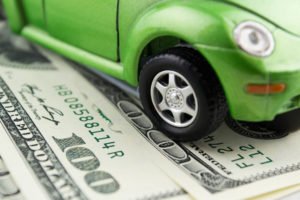Consumers’ defenses go on high alert when they step into the F&I office to finalize a deal. By that time, they have spent hours in the showroom and researching online, and they just want to drive their car off the lot. Yet, they have to sit through one more sales pitch — for add-on products, such as extended warranties, guaranteed asset protection (GAP) insurance, and service contracts.
Lenders know that during this part of the sales process, dealer relationships are on the line, consumer satisfaction is at stake, and deal structure could put the borrower into early delinquency.
F&I managers have their bosses tailing them to increase profits because, in the current environment of rising rates and dealer consolidation, profits from ancillary products are increasingly the lifeblood of a dealership.
“Obviously, we’re dependent upon it,” said Michael Haywood, a finance manager at Stone Mountain, Ga.-based Gwinnett Chrysler Dodge Jeep Ram. “That’s our responsibility as finance managers, to be able to convert those types of products into a car deal. We focus on warranty, maintenance, and GAP, so when a customer comes into my office, those are the three I’m trying to drive home.”
Anecdotally, everyone interviewed for this story agreed that ancillary product sales are increasing, but no one could point to definitive industry-wide numbers to back the trend.
AutoNation Inc., the largest dealership group in the U.S. by retail sales, provides a good benchmark. The dealer chain reported finance and insurance profits of $1,766 per vehicle, on average, in the first quarter. F&I profits per vehicle have increased 8.7% year over year — and 26.3% over four years.
To put those figures in perspective, in the first quarter, AutoNation recorded more profits, on average, from F&I sales per car than from the actual sale of the car — regardless of whether the vehicle was new or used.
With interest rates on the rise, auto sales on the decline, and the financing space still fiercely competitive, lenders only have a few ways to increase contract volume, said Jeffrey Fritz, executive vice president and chief financial officer of Consumer Portfolio Services.
“Lenders could lower rates, which hits your pocketbook right at the outset,” Fritz told Auto Finance News. “Or you can offer the dealer more incentives from a profitability standpoint in terms of add-on packages, and that’s the lever that some finance companies have decided to pull. It’s certainly our perception and observation that some finance companies are getting more aggressive on back-end profitability opportunities for the dealers.”
A Growing Trend
While this trend may have been developing for a number of years, the rising price of cars and increasing levels of consumer debt are spurring ancillary product sales, said Zach Doran, president of the Ohio Automobile Dealers Association.
The average price of a new car is north of $35,000, according to Kelley Blue Book, and national household debt rose to $13.2 trillion as of March 31, the highest peak since it hit $12.7 trillion during the Great Recession, the Federal Reserve reported in its first-quarter Household Debt and Credit report. Auto is the third-largest category of debt for consumers, at $1.23 trillion, compared with $810 billion during the recession.
With all that debt, savings accounts are limited, and consumers are less likely to financially weather life events such as car crashes. Furthermore, the lack of savings makes down payments more difficult, which exacerbates negative equity — a situation in which the consumer owes more on the loan than the car is worth.
Collision and comprehensive insurance covers only the value of the car, which could fall short of the outstanding loan balance.
“Many people need products like GAP insurance, because they help protect the consumer if their vehicle is damaged and they still have loans to pay off,” Doran said. “People are shopping based on a monthly budget constraint, and when significant costs with respect to repairs are needed, an unforeseen event occurs, or if they don’t bring a significant amount of cash to the deal, it can keep them upside down for a number of years while they make payments toward more of an equity position.”
With new-car sales expected to decline this year, OEMs continue to push incentives and look for ways to boost volume through their captives. One strategy is for lenders to lift restrictions on ancillary product sales.
In fact, many captives sell their own branded add-on products, giving dealers incentives to use those products rather than the competition’s offerings, CPS’s Fritz said. For example, a captive could offer an extra $200 to the dealership if it uses the company’s branded product. Or, lenders may raise caps on loan-to-value ratios if ancillary product sales go toward the captive’s products.
“It’s not uncommon for finance companies to tell the dealer, ‘You can make a couple extra bucks selling our product,’” Fritz said. “Or [the lender] could say, ‘You can only sell our products,’ although that would be pretty limiting.”
Hyundai Capital America, for one, is simplifying the menu of branded products it offers by bundling some of the disparate products into easy-to-understand packages, said Scott Belkofer, vice president of Hyundai Capital Insurance.
“It does a couple things,” he said. “It potentially lowers the overall cost and, in some ways, it simplifies the consumer sales process, because when consumers review the F&I menu of products, rather than 13 or 14 individual products, they might review a few bundled options.”
The Dealer’s Gain Is the Lender’s Loss
While these increased sales of ancillary products are good for dealers, they are not necessarily good for lenders, Fritz said.
“There are products that are not perceived to have as much value — like a paint coating or tires for life,” he said. “Dealers sell the product in the closing booth, and the consumer feels like it’s a good product. It adds profitability to the dealer’s back end. But, if the cost of that product goes into the loan, from the lender’s standpoint, this doesn’t really help because all it’s done is increase the financed amount of the loan without increasing the value of the collateral.”
In other words, the add-on sales increased the consumer’s monthly payment and, thus, the likelihood of default. If that default turns into a repossession, some of these ancillary products will do little to increase collateral value at auction.
To that end, CPS funds only GAP waivers and service contracts. But Hyundai Capital America offers a full suite of ancillary products, including key replacement, along with paint and interior protection.
While ancillary products may deliver little value to lenders, happy, profitable dealers spur contract volume, so there is a balancing act.
“If another lender is comfortable with financing the less-value-added products, or if a lender is comfortable allowing higher LTV limits, then it gives the dealer more flexibility and profitability opportunities,” Fritz said.
Dealers tell CPS sales reps daily that competition in the ancillary product space is why a CPS-approved deal went to a competitor. “We get that it might put us at a competitive disadvantage,” Fritz said. “But, we’re buying the kind of structure that we’re comfortable buying.”
Protecting Against Abuse
Fraud in ancillary product sales happens on a spectrum. At the most egregious end, a dealer can slip a GAP waiver into the pile of documents being signed, and consumers don’t realize they’re paying for it until months later. Somewhere in the middle, consumers are pressured into buying contracts because dealers falsely claim that add-on products are required for financing to be approved.
One such case was the subject of a 2013 lawsuit — Freeman v. A Better Way Wholesale Autos Inc. — that was appealed in 2017. The add-ons would have increased Sharay Freeman’s car payments to $447 per month, compared with the initial quote of $320 per month. She would have paid an additional $5,334 over the life of her 42-month loan had she been pressured into buying the products.
However, established lenders in the industry have implemented controls to prevent these abuses, which makes outright fraud rare, David Gemperle, an attorney in Nissen & Elliott’s auto finance group, told AFN.
“The lenders aren’t at the dealership, so they can’t control the dealer’s sales process for promoting the products,” Gemperle said. “However, lenders can limit the dollar amount or percentage they will advance as a matter of the collateral.”
For GAP products, many lenders perform a calculation to determine whether the product will provide value to the consumer. For example, if a consumer puts down 50% of the purchase price at signing, he will always have equity in the vehicle. The lender can make a more precise calculation to determine the tipping point between value-add to worthless, thereby protecting the consumer.
But there is another kind of abuse on the grey part of the spectrum that’s harder to track — pricing markups.
Unlike the insurance industry, where premiums are set by insurers and agents are given set commissions, dealers stand to profit from higher ancillary product pricing — even if it’s capped by lenders. F&I managers are sometimes incentivized by commissions to increase ancillary product prices.
Pricing can be marked up multiples of what it costs the dealership to provide the product. Some dealers institute fixed pricing, where all products cost the same; whereas, others give more wiggle room to F&I managers to mark up costs. For example, an October 2017 study conducted by the National Consumer Law Center surveying 105 dealers found that window etching prices ranged from $1 to $1,995.
Dealers may also be incentivized by loan markups. Lenders cap this rate, as well, but the more add-on products a dealer loads onto the total amount financed, the bigger the payout from the dealer markup.
While lenders often restrict how much borrowers can be charged in add-on fees, they usually don’t know how much the ancillary products cost the dealership and, thus, how much the product was marked up.
“In some cases, [lenders] will even look at the pricing, but that’s hard to do because you don’t have complete awareness of all the features of all the products,” Gemperle said. “Lenders typically have a preferred provider list that they want dealers to use, but that’s not to say someone is actually reading every single [ancillary product] contract. It would be onerous to do so.”
Discrimination at the dealership is another consideration, because when F&I managers are given the flexibility to choose the price of the add-on product, unconscious bias can creep into the process.
By law, dealerships and lenders are not allowed to collect data on race, but the National Consumer Law Center’s study used surnames to track discriminatory ancillary product pricing. Tracking consumers over a three-year period in 48 states, the study found that Hispanic consumers paid more for add-on products than their white counterparts in 44 of those states.
The Bureau of Consumer Financial Protection used a similar methodology to track discrimination in dealer markups, but the industry has long decried the use of last names to track racial discrepancies as problematic.
Gemperle noted that ancillary products are similar to other retail items. If the corner store wants to charge $1,000 for a pack of gum, the manager can make that decision, but customers will probably go elsewhere to buy gum at a cheaper price. Likewise, consumers can go to dealerships charging fewer fees.
However, the pricing for these products is largely inconsistent and unclear, which makes it hard for consumers to be properly informed, even if they take the time to learn the ins and outs of GAP waivers, said John Van Alst, an attorney with the National Consumer Law Center.
“We need clear and consistent pricing, so you can do some consumer research,” Van Alst said. “[Inconsistent pricing] leads to discrimination, but even if it didn’t, it just doesn’t lead to informed consumers.”
Fraud and pricing mishaps are largely self-policed within the dealership community, the OADA’s Doran said.
“A dealership’s reputation is everything,” he said. “The best thing for the dealer is to sell a car and have a happy consumer. A happy customer tells one person about their experience, but a disgruntled customer will go out and tell 10 people.”
Of course, some consumers are always going to feel they’ve wasted their money because, ultimately, “these are insurance products, and much like other insurance products they are only good when you need them,” Hyundai Capital America’s Belkofer said. “I’m positive we don’t sell anything that won’t in some way, shape, or form wind up being a customer benefit if a certain incident arises. All these F&I products have some value, but it’s no different than regular auto insurance — you don’t need it until you have a claim.”
One thing that could help is if consumers can engage with the products to a greater degree before they get to the F&I office, he added. Hyundai Capital America is in the early stages of developing a pilot that will allow consumers to shop add-on products at home, but still allow the F&I manager the opportunity to pitch the sale. Belkofer believes the pilot will show that consumer acceptance will improve or at least stay flat.
“You walk into the finance office to finalize everything, and all defenses go up,” he said. “That’s the piece of the sales experience I’d most like to change. And I think we do that by having the consumer more engaged with the process overall, which is inclusive of the ability to research up front.”
Source : AutoFinanceNews















![Webinar: Simplifying Titling with Tax and Fee Estimates [SPONSORED] | Auto Finance News](https://www.oneworldmedia.us/news/wp-content/uploads/2018/04/canstockphoto25762222-100x70.jpg)